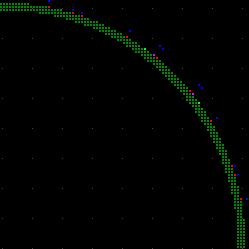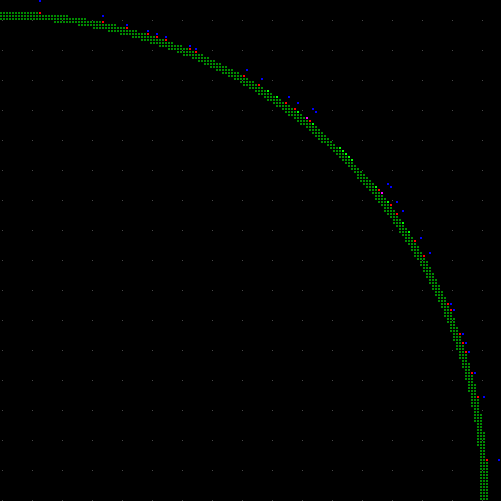 |
Basic Ideas |
 |
Regular Engine |
 |
Gravitonic Engine |
 |
Farther? |
 |
Articles |
 |
VGAP Main Page |
A question coming up periodically is: how far can you get in one turn? Or, more interesting: will I make this in one turn?
Since this is not obvious from movement formulas (due to the rounding involved), I have simulated the problem. I used HOST 3.22.046, which is probably the most-widely used HOST version today. As far as I know, the movement algorithm has been unchanged since HOST 3.22.026.
Basic Ideas
Movement uses relative coordinates. When you move from (1200,1300) to (1250,1320), you're moving 50 ly on the X axis (east), and 20 ly on the Y axis (south). When you move from (2512,1991) to (2562,2011), you're also moving (+50,+20), so you will take the same relative path, burn the same amount of fuel, and take the same number of turns. Therefore, it suffices to talk about relative movement. Since you can move at most 81 ly each turn, it suffices to simulate relative movement of about +/-81 ly. This is what I did.
Movement can have two results:
- You can reach your waypoint exactly. This is the normal case.
- You can miss your waypoint because it's too far. Normally, you don't want that. However, it is possible that by ordering your ship to go far, it may end on a spot you cannot reach normally due to rounding effects. Thus, this is the trick that will save your ass once in a lifetime.
There are three interesting figures:
- Maximum safe distance: this is the number you'll want to learn: all points that are closer than this can be directly reached. Always.
- Maximum exact distance: some points farther than the safe distance (but not all) can be reached as well.
- Maximum inexact distance: some points even farther can be reached by setting an inexact waypoint. You will not reach it, but still end farther away than you could regularily.
Warp 9 using a Regular Engine

- Maximum safe distance: 81.57 ly.
- Maximum exact distance: 81.61 ly using a displacement of (66,48).
- Maximum inexact distance: 81.84 ly using a displacement of (67,53). The ship will move (64,51).
Points outside safe distance which are reached exactly:
| Waypoint Displacement | Distance |
|---|---|
| 48,66 | 81.61 ly |
| 66,48 | 81.61 ly |
Points which are reached inexactly:
| Waypoint Displacement | Distance | Reached Point | Distance |
|---|---|---|---|
| 16,82 | 83.55 ly | 16,80 | 81.58 ly |
| 24,79 | 82.57 ly | 24,78 | 81.61 ly |
| 27,78 | 82.54 ly | 27,77 | 81.60 ly |
| 43,72 | 83.86 ly | 42,70 | 81.63 ly |
| 53,67 | 85.43 ly | 51,64 | 81.84 ly |
| 54,66 | 85.28 ly | 52,63 | 81.69 ly |
| 66,54 | 85.28 ly | 63,52 | 81.69 ly |
| 67,53 | 85.43 ly | 64,51 | 81.84 ly |
| 72,43 | 83.86 ly | 70,42 | 81.63 ly |
| 78,27 | 82.54 ly | 77,27 | 81.60 ly |
| 79,24 | 82.57 ly | 78,24 | 81.61 ly |
| 82,16 | 83.55 ly | 80,16 | 81.58 ly |
How to interpret the diagram
The diagram contains all reachable points in green or red color. Note that for simplicity points closer than 79 ly have been left out. Those are always reached. The gray dots mark a 10 ly grid.
| green | Points reached exactly |
| green | Points reached exactly, and within safe distance |
| red | Points reached inexactly |
| red | Points reached inexactly, at maximum possible distance |
| blue | These are the points you use as a waypoint to reach the corresponding inexact point |
Warp 9 using a Gravitonic Engine

- Maximum safe distance: 162.505 ly.
- Maximum exact distance: 162.659 ly using a displacement of (117,113).
- Maximum inexact distance: 162.89 ly using a displacement of (130,104). The ship will move (127,102).
Points outside safe distance which are reached exactly:
| Waypoint Displacement | Distance |
|---|---|
| 89,136 | 162.53 ly |
| 92,134 | 162.54 ly |
| 99,129 | 162.61 ly |
| 104,125 | 162.61 ly |
| 113,117 | 162.66 ly |
| 114,116 | 162.64 ly |
| 115,115 | 162.63 ly |
| 116,114 | 162.64 ly |
| 117,113 | 162.66 ly |
| 125,104 | 162.61 ly |
| 129,99 | 162.61 ly |
| 134,92 | 162.54 ly |
| 136,89 | 162.53 ly |
Points which are reached inexactly:
| Waypoint Displacement | Distance | Reached Point | Distance |
|---|---|---|---|
| 13,166 | 166.51 ly | 13,162 | 162.52 ly |
| 34,161 | 164.55 ly | 34,159 | 162.59 ly |
| 42,158 | 163.49 ly | 42,157 | 162.52 ly |
| 49,156 | 163.51 ly | 49,155 | 162.56 ly |
| 52,155 | 163.49 ly | 52,154 | 162.54 ly |
| 55,154 | 163.53 ly | 55,153 | 162.59 ly |
| 63,151 | 163.62 ly | 63,150 | 162.69 ly |
| 65,150 | 163.48 ly | 65,149 | 162.56 ly |
| 82,143 | 164.84 ly | 81,141 | 162.61 ly |
| 87,140 | 164.83 ly | 86,138 | 162.60 ly |
| 96,134 | 164.84 ly | 95,132 | 162.63 ly |
| 99,132 | 165.00 ly | 98,130 | 162.80 ly |
| 104,130 | 166.48 ly | 102,127 | 162.89 ly |
| 105,129 | 166.33 ly | 103,126 | 162.74 ly |
| 129,105 | 166.33 ly | 126,103 | 162.74 ly |
| 130,104 | 166.48 ly | 127,102 | 162.89 ly |
| 132,99 | 165.00 ly | 130,98 | 162.80 ly |
| 134,96 | 164.84 ly | 132,95 | 162.63 ly |
| 140,87 | 164.83 ly | 138,86 | 162.60 ly |
| 143,82 | 164.84 ly | 141,81 | 162.61 ly |
| 150,65 | 163.48 ly | 149,65 | 162.56 ly |
| 151,63 | 163.62 ly | 150,63 | 162.69 ly |
| 154,55 | 163.53 ly | 153,55 | 162.59 ly |
| 155,52 | 163.49 ly | 154,52 | 162.54 ly |
| 156,49 | 163.51 ly | 155,49 | 162.56 ly |
| 158,42 | 163.49 ly | 157,42 | 162.52 ly |
| 161,34 | 164.55 ly | 159,34 | 162.59 ly |
| 166,13 | 166.51 ly | 162,13 | 162.52 ly |
Can you go farther?
A number of things can allow a ship to go farther:
- Hyperdrive and Chunnel, of course.
- Gravity wells.
- Ion storm surfing.
- Wormholes and jumpgates of all kinds.
These have not been discussed here, because they are well-known, trivial, unpractical, and add-on dependant, respectively. However, it helps to keep these in mind when you're asking yourself will my enemy make this in one turn?
Colophon
This analysis was first published in news:alt.games.vga-planets article <busg0k.1kg.1@stefan.msgid.phost.de> in January 2004. It has been prepared anew from the original data. You can download the data and scripts to produce it here (80k ZIP).
Inevitable ad block: PCC uses actual movement formulas to optimize waypoints. When you shift-click at a planet, it will use all applicable points, including inexact ones, to find the fastest possibility.